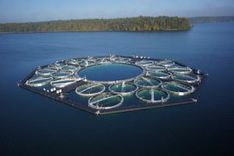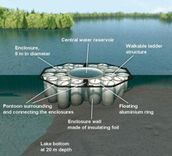Facilities
Transnational Access
Metadata & Data
Papers & Reports
Knowledge Base
IGB LakeLab
Leibniz Institute of Freshwater Ecology and Inland Fisheries (IGB) / Leibniz-Institute für Gewässerökologie und Binnenfischerei (IGB)
Infrastructure Description
The LakeLab in the deep clear-water Lake Stechlin, NE Germany, consists of 24 cylindrical enclosures encompassing large water volumes of 1270 m3 (9m diameter, 20m depth) each. The special features of the LakeLab are the unique combination of large size and number of mesocosms enable multi- factorial designs and new research perspectives, including testing of large instruments and calibration opportunities (e.g. remote sensing) not possible in most mesocoms. Further, flexible curtains attached to aluminium floats extending into the sediment enable experiments on benthic-pelagic coupling also during winter, including manipulation of ice and snow coverage. Water renewal by special high-throughput impeller pumps (100 m3/h) minimise disturbance of plankton and provide excellent tools to manipulate mixing regimes and stratification patterns. Gases (N2, CO2, CH4) and solutes can be injected in air-lift systems, whereas application of xenobiotics or introduction of foreign species is precluded. All 24 units of the LakeLab are equipped with automated sensors mounted on vertical profilers recording water-quality parameters at high-resolution: PAR, pressure, temperature, pH, conductivity, O2 and chlorophyll. Four identical profilers are deployed in the lake at the LakeLab. All profilers are controlled by industrial computers collecting and transmitting data in real-time to a central data base server. The LakeLab is in close proximity to well-equipped laboratories of IGB’s Department of Plankton and Microbial Ecology, located directly on the lakeshore. Quick boat access (<5 min) to the laboratories facilitates prompt analyses of delicate live samples. Laboratories include radioisotope lab (14C,3H,33P,35S), molecular S1 labs, walk-in climate rooms, and standard labs. Analytical instruments include autoanalysers for nutrients, ion chromatograph, UV-Vis spectrophotometers, fluorospectrophotometer, fluorimeter, TOC/TON analyser, CNHS analyser, CaCO3 analyser, GCs, HPLCs, ultracentrifuge, flow cytometers, FlowCAMs, picture based flow cytometer, zooplankton scanner, software for picture recognition and machine learning approaches, scanning electron microscopes, bright-field, epifluorescence and inverted microscopes, image analysis systems, other standard laboratory equipment and field gear (multiprobes, plankton nets, sedimentation traps, sediment corers, layer sampler, underwater video system, IFCB). The long-term monitoring programme on Lake Stechlin provides background data on water chemistry, phyto- and zooplankton, fish, primary and bacterial secondary production. Meteorological data are recorded by the German Environment Agency on site.

Facility Description
Outdoor – pelagic/benthic – freshwater
24 large lake mesocosms, each 9 m diameter, 20 m depth, reaching into the sediment, water volume 1,270 m3 per mesocosm, one additional central unit 30 m diameter, volume 14,000 m3
Organisation Address
Leibniz-Institute of Freshwater Ecology and Inland Fisheries (IGB)
Müggelseedamm 310
Berlin
12587
Germany
Infrastructure Address
IGB LakeLab
(Lake Stechlin 80 km north of Berlin)
Department of Plankton and Microbial Ecology
16775 Stechlin/Neuglobsow
Germany
Information Sources
Location
Gallery
Contacts
Stella Berger
Jens Nejstgaard
Controlled Parameters
e.g. thermocline depth, stratification/mixing, browning, nutrients (N,P), connectivity and retention time, artificial light at night (ALAN), winter conditions (Ice, no ice, snow)
Research Topics
Responses of the planktonic food web, biodiversity patterns, biogeochemical processes, and fluxes under climate change scenarios, effects of extreme weather events on aquatic ecosystems, ALAN and diel vertical migration of zooplankton, connectivity of aquatic ecosystems, remote sensing ground-truthing, metabolism, GHG.
Experiment Years
2011 - present
TA Support
Services currently offered by the infrastructure: Users will benefit from the exceptional facilities and experience with aquatic mesocosm research provided by the IGB team. Since its implementation in 2012, the LakeLab has attracted numerous international scientists for experiments conducted between 2013 and 2018. The involvement of the University of Pannonia (Hungary) and the Institute for Baltic Sea Research (IOW) played central roles in experiments carried out in 2013 and 2014. The LakeLab experiment in 2015 was co-led by the Norwegian national institute (NIVA) and involved 60 participants. The first TA provision in 2018 to users from Spain, Serbia, and Austria was successfully incorporated into up to 70 participants during the large-scale LakeLab experiment (Fig.9.1). Important results of the experiments conducted so far relate to the effects of lake mixing regimes, extreme events, browning, nutrient loading and artificial light at night on lake ecosystem structure and function. Future TA provision in 2019 to TA users from Australia, Austria and Spain will expand the outreach of large-scale experiments in worldwide networks with expressions of interest by international scientists abroad.
Support offered under AQUACOSM: Users will have access to the laboratories and instrumentation at the LakeLab and IGB laboratories. However, to maximise benefit of on-site support and output, scientific cooperation with scientists at IGB Stechlin is strongly encouraged and will be supported by permanent technical IGB staff. Users are also encouraged to engage in scientific activities beyond AQUACOSM (participation in seminar series, journal club, group meetings). Experience from mesocosm experiments at other locations has shown that extended collaborative experiments offer excellent opportunities for networking and creative exchange that produces innovative ideas on scientific questions and industrial and environmental applications. Therefore, users are invited to get involved in social activities organised by both local staff and visitors. The relatively small size and remoteness of IGB Stechlin ensures ample opportunities for such informal exchange. This will be further facilitated by the offered accommodation at IGB’s fully equipped (kitchen, laundry facilities, garden) guesthouse (23 beds) in the nearby village at 20 min walking distance.
Support offered under AQUACOSM-plus: Users will have access to offices, laboratories and equipment described above in cooperation with responsible scientists and permanent technical IGB staff. Further facilities and instruments (e.g. ROVs, genomics/proteomics labs) can be made available at IGB and collaborating laboratories at research institutes and universities in Berlin. Users are encouraged to engage in scientific activities beyond AQUACOSM-plus, i.e. seminars and group meetings. Experience from earlier mesocosm experiments have shown that extended collaborative experiments offer excellent opportunities for networking and creative exchange that produces innovative ideas on scientific questions as well as industrial and environmental applications.
TA Modality of Access
Modality of access under AQUACOSM: A total of at least 720 person days will be allocated to external users through Transnational Access provided under AQUACOSM for 3 years. It is anticipated that AQUACOSM will support stays of at least 4 persons for 60 days in years 2-4. The very large units of the facility means that experiments tend to run longer than in other mesocosm facilities. Consequently, a duration >30 days is typically expected to complete independent projects. Since logistic preparation of experiments at the LakeLab takes at least 6 months, TAs are anticipate to focus initially on integrating external users in activities already in the planning stage, specifically in experiments on brownification and light pollution planned in 2017 and 2018 as part of 2 funded projects. However, in addition to encouraging proposals for large experiments as soon as logistically possible, individuals and smaller groups are invited to apply for AQUACOSM TA support to cooperate at any time within more comprehensive projects, both planned and unplanned at present, resulting in joint publications of results and management recommendations. To maximise synergies, AQUACOSM activities will also be coordinated with long-term monitoring and other projects conducted in the LakeLab and Lake Stechlin.
Modality of access under AQUACOSM-plus: A total of at least 600 person days will be allocated to external users through TA provided under AQUACOSM-plus. It is anticipated that AQUACOSM-plus will support stays of at least 6 persons for 50 days per year in M10-21 and M34-45. Due to the very large units of the facility, experiments run relatively long and consequently, durations of about 30 days are expected to complete independent projects. Since logistic preparation of LakeLab experiments take about 6 months, it is anticipated to integrate external users already in the planning stage. In addition to encouraging proposals for large experiments as soon as logistically possible, individuals and groups are invited to apply for AQUACOSM-plus TA support to cooperate within more comprehensive projects resulting in joint publications of results and management recommendations. To maximise synergies, AQUACOSM- plus activities will also be coordinated with long-term monitoring and other projects conducted in the LakeLab and Lake Stechlin.
TA Accommodation
Accommodation is offered at IGB’s fully equipped guesthouse (kitchen, laundry facilities, garden) with 23 beds in the nearby village Neuglobsow at 20 min walking distance.


